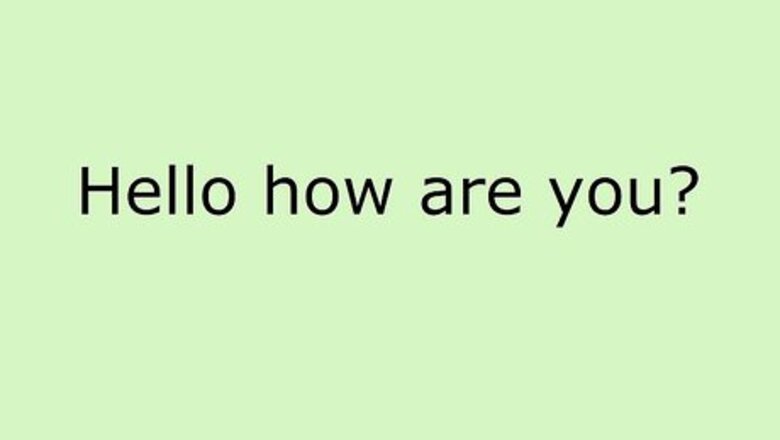
views
Manipulating Letter Orientation
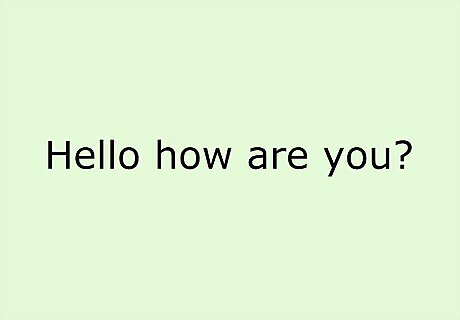
Craft your message normally. Before you start to write in code, you'll need to know what your message is going to be. Depending on how much secrecy you want in your coding, you may not want to share your information with anyone around you. This means that you'll have to be careful that no one surrounding your desk will see your paper, as the code will quickly be broken. If you don't think that you can write your message without it being seen, you can try to visualize it in your head instead. While this can be more difficult, it's best not to be found out by those around you, or your teacher.
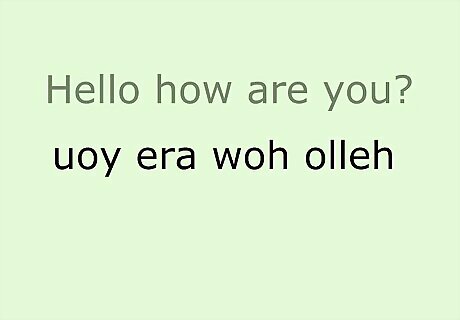
Write your message backwards. This is one of the easiest codes to begin with, especially if you haven't shared coded messages with anyone before.Take your initial message and write it backward, one letter at a time. Start at the bottom right hand corner of the page, so you're moving to the left and up, rather than down and right, like you would normally write. When you're finished with the message, write your punctuation at the end. This will dictate where your message begins and ends. Make sure that you're separating each word in your message, even though they look a little funky and abnormal. If your letters blend together, then the message will be fairly unreadable.
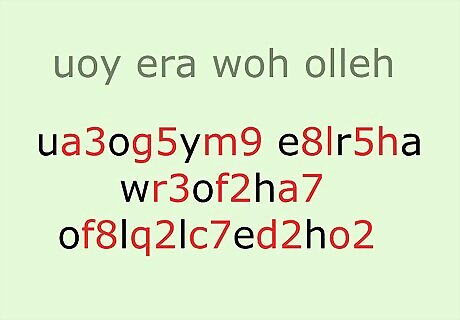
Insert a letter and number between each backward letter. If you can without arousing suspicion, write your message on a piece of paper. Proceed to write your message backward, starting from the bottom-right corner of the page and moving to the upper-left. With each letter that you write, insert any number and letter between the letters of your code. There's no exact science to the letters and numbers that you choose, so don't overthink it. "Hello how are you?" would be: "ua3og5ym9 e8lr1sa5h wr3of2ha7 of8lq2lc7ed2ho2".
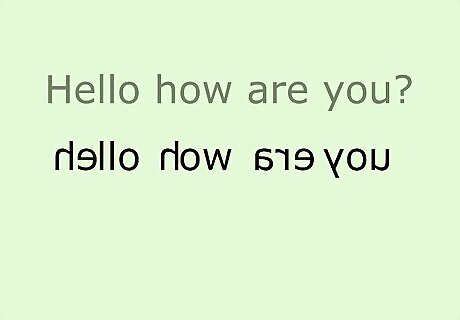
Flip your letters. Another fun strategy in writing code is flipping your letters in reverse, so you're left with a strange looking, non-English code. You might want to practice this one before trying it in class. Write a letter in regular handwriting and study its form. You'll start from the right side of the page and move to the left, writing with your left hand. Each letter will be flipped in its form, so you'll be writing backwards while also drawing the shape of the letter in reverse. After you've written your message, hold it up to a mirror. You will see it written in normal English. This is a fairly advanced code and may take some time to master. If you're left handed, this one might be a bit more difficult to learn, but you can still try writing from right to left and mirroring the letters.
Reversing the Alphabet
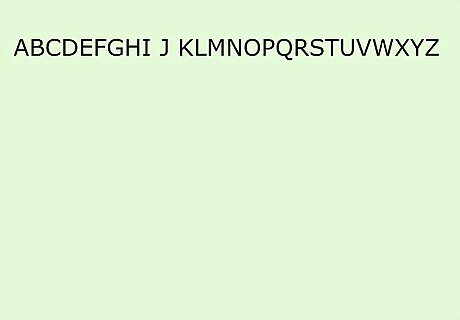
Make a list of the alphabet. Start your coding by writing out the entire alphabet neatly, giving ample space to write directly below it. You'll be organizing your codes on a single sheet of paper, so you don't want to run out of room. Your alphabet should fit into one uniform row.
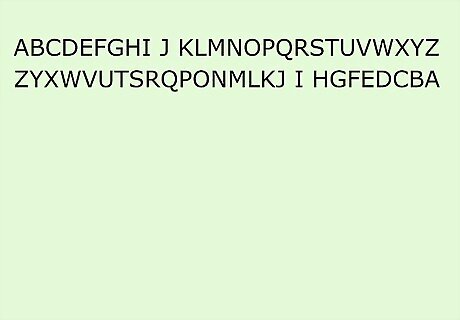
Correlate each letter with its opposite in alphabetical order. Go through the alphabet, after you've written it out in normal order, and write it in reversed order. This means that Z will sit under A, Y under B, X under C, and so on. It's good to write it out completely, as this will help you visualize the entirety of your code. Start to memorize the code, as this will save you time in writing it out in the future. Know that by practicing it, you will grow more comfortable working in the code eventually.
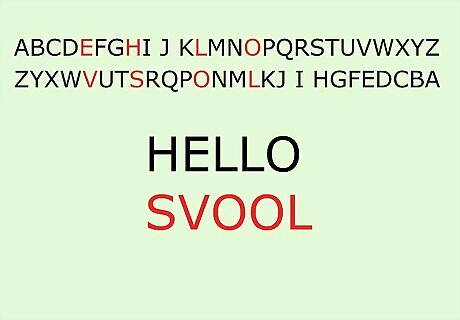
Compose your message using your reverse alphabet. Using the code as a guide, you'll begin to translate your message into your reversed code. Start by writing out your message in normal English. Below this, you'll use your key to translate this message into the reversed alphabet. The message "HELLO," for example, would be read as "SVOOL." When decoding a message, look at the bottom row of your key and follow to the letter above. The letter above will correlate to the letter in English.
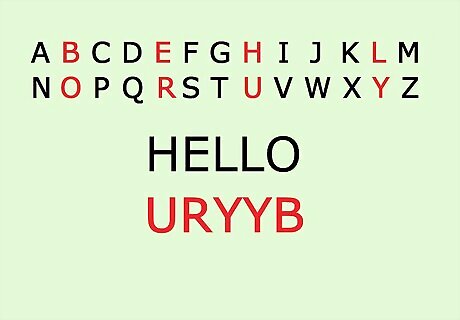
Learn the half-reversed alphabet.This method, while fairly similar to the reverse alphabet, can save you time in both coding and decoding. It will also save you time in writing out your key. To prepare to write in this code, simply write the letters A through M and then write the rest of the alphabet, N through Z, underneath them. When translating using the half-reversed alphabet, A will equal N, and N will also equal A. It's a two-way correlation, so some people find will find it easier and quicker to assess when translating.
Representing Letters with Symbols
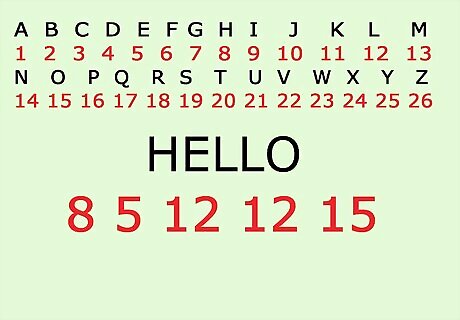
Connect each letter to its numerical equivalent. This code, while fairly straightforward, is an easy way to begin assigning symbols to your alphabet. Write out the alphabet in its standard order. After this, go through and number each letter of the alphabet from 1 to 26 so that A=1, B=2, and complete this pattern. This code, while fairly simple, is also easy to crack. You could try switching it up by reversing the order of the numbers from the beginning (A=26), or by numbering normally for the first half of the alphabet and reversing your numbers when you hit the half-way point, so that N=26, O=25, and so on.
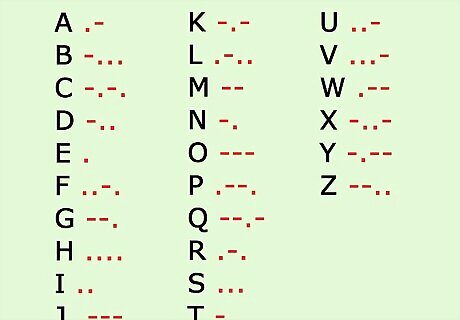
Dictate in Morse Code. While most people think of Morse Code as a series of sounds and lights, rather than something that can be written, there are shorthand symbols for each letter in the code.Morse Code, named after its inventor Samuel Morse, was used to quickly send messages through telegraphs in the 1830s. Each letter will be composed of a series of dots and dashes. Compose a key of the various correlations and use it as a guide when writing in this code. For advanced coders, there are Morse Code symbols that also represent all forms of punctuation. Try spicing up your messages by writing full sentences, divided by periods, commas, and exclamation points, within your Morse Code.
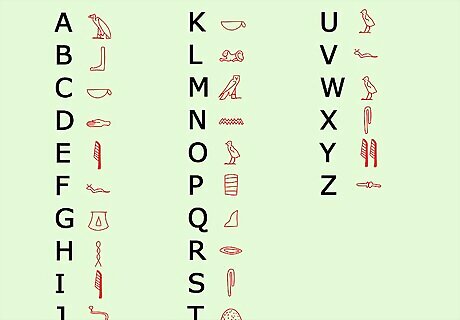
Learn hieroglyphics. Invented in Ancient Egypt, hieroglyphics is old system of writing language that combines a more traditional alphabet with symbolic drawings.What's a bit tough about learning hieroglyphics is that it not only relies on letters, but also on sounds. When writing the letter A, for example, you'll have to memorize the symbols for both the long and short vowel sounds. Write out a key that not only includes the letters of the English alphabet, but also the sounds that have been assigned their own symbol in hieroglyphics. You'll see that the shared letters often have the same basic design, and that there are small modifications that correlate to each sound or combination of letters. Discover the joy of secret messages. "As a kid, I was obsessed with passing coded notes to my friends, but I only knew basic pig Latin and number-for-letter substitutions. Reading this guide opened up a whole new world — I learned about 10 new ways to secretly encode messages! I had a total blast surprising my buddies by slipping them these complex coded notes. It made me feel like a secret agent or something. It's a super fun way to spark creativity." - Jacoub R. Reconnect with loved ones through coding. "When I was little, my grandpa taught me Morse code, so it was really nostalgic reading about it in this article. I decided to brush up on it and write him a letter in Morse code. Even though his eyesight is fading, he could still make out the dots and dashes. We had such a good laugh together decoding my letter. It was a great way to bond and bring back fond memories." - Joseph M. Make math class more exciting. "As a middle school math teacher, I'm always trying to find ways to engage my students more. This article was full of so many cool coding ideas that I can use to liven up lessons on variables, symbols, sequences — all kinds of math concepts! When I assigned some secret message projects, it really boosted the class's interest and comprehension. The kids just light up and can't get enough of it!" - Sophie M. Have fun with kids through codes. "As a parent, I love doing activities with my kids that we both really enjoy. We had a total blast making up our own secret code and leaving coded messages for each other around the house. It sparked their creativity and brought lots of laughter into our home. This article was such a great source of inspiration for quality bonding time." - Ella S. Did you know that wikiHow has collected over 365,000 reader stories since it started in 2005? We’d love to hear from you! Share your story here.
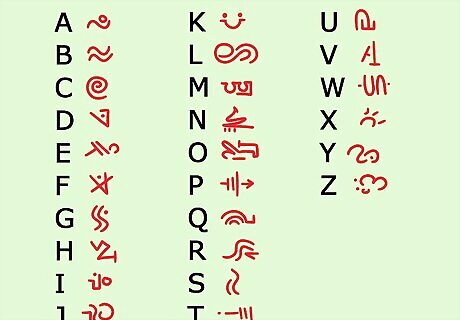
Invent your own code. While you can certainly use these existing codes, or other codes that exist in the world, it can be fun to create your own. Get together with a friend and assign a symbol to each letter in the alphabet. Keeping these designs fairly simple will be helpful in mastering your own code. It's also very important that you hold onto your key, as you don't want to forget your methods.
Learning Advanced Codes
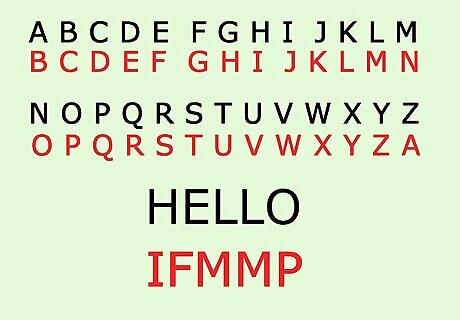
Alter your language with a sliding scale. A sliding scale, sometimes known as a cryptograph, takes our traditional alphabet and slides it in one direction, giving each letter a newly assigned code letter. The simplest way to do this is to slide the entire alphabet down a single letter. This means that A will be represented by B, B by C, until Z will eventually be represented by A. You can go beyond this single move, however, and slide the alphabet down multiple places. This will make your code more advanced, as a one letter slide can be cracked fairly easily. You can also slide the alphabet backwards. This requires a bit more planning, however, as you'll have to work from the latter side of the alphabet, move past Z, and then start from A. This strategy is also known as "ROT1," which stands for "rotate one letter forward." You can apply this to more advanced scales if you would like. ROT2, for example, would stand for "rotate two letters forward."
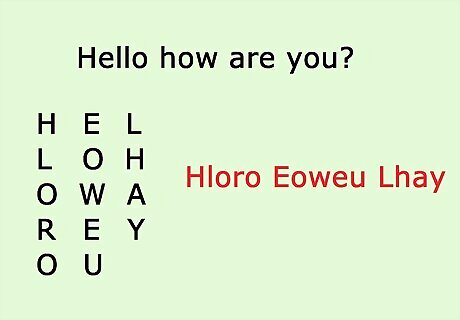
Work with the Block Cipher method. Start by writing out your message in one rectangular block, moving one row at time.You'll want to preplan this a bit, as each row should be as close to even, in its length, as possible. It may not line up perfectly, however. Once you've written out your blocks, move vertically down each column. Each vertical column will be its own word of a nearly equal length, if you've planned your rows evenly. When decoding these messages, write your code words as individual columns again, and you'll be able read the message in row form again.
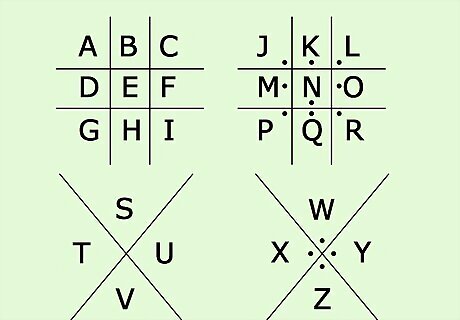
Master the Pigpen Code. The Pigpen Code, often referred to as to masonic cipher, is one of the most advanced codes to write within. Make sure that you write it out clearly in an organized fashion, as you'll want to be returning into it when you're writing and decoding these messages.Draw your two major grids. One will look like a tic-tac-toe board, and the other will look like a massive X. You'll fill in the thirteen holes of the two grids with two letters each. Compare the codes for A and J. Both will have the same major shape, but J, because it's the second grid, gets a dot attached to it. This will apply to all of the shared spaces. The first will be plain, and the second has a dot. It may help to write each letter out individually in its code to compare them with each other.



















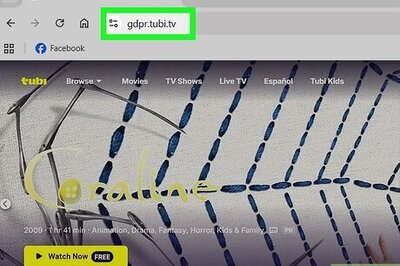
Comments
0 comment